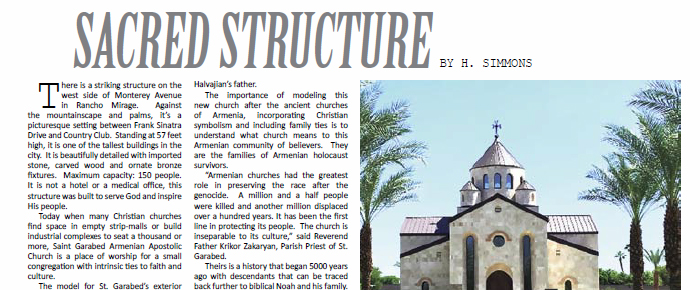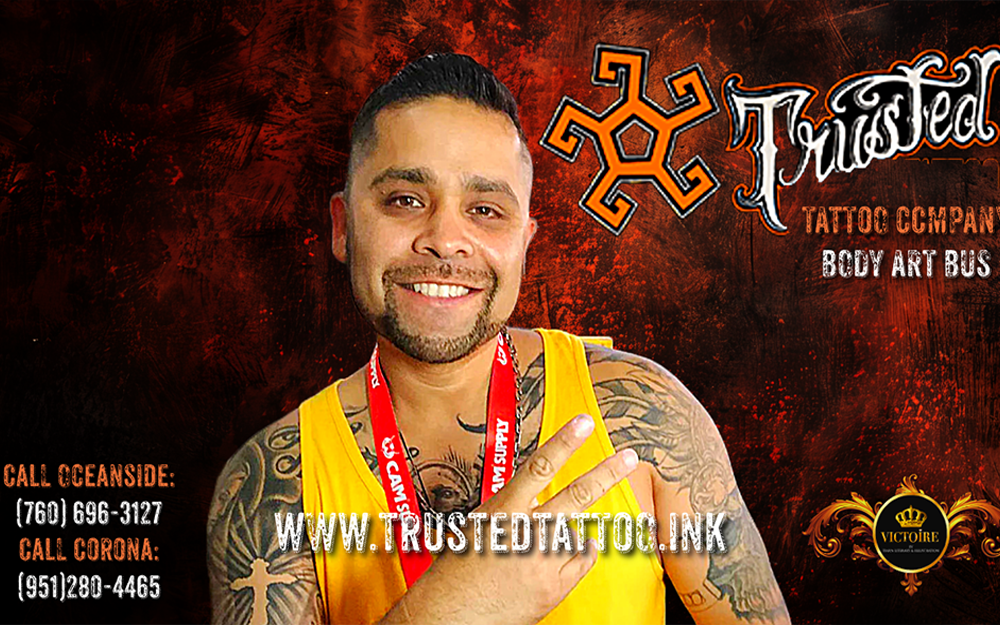
By H. Simmons
There is a striking structure on the west side of Monterey Avenue in Rancho Mirage. Against the mountainscape and palms, it’s a picturesque setting between Frank Sinatra Drive and Country Club. Standing at 57 feet high, it is one of the tallest buildings in the city. It is beautifully detailed with imported stone, carved wood and ornate bronze fixtures. Maximum capacity: 150 people. It is not a hotel or a medical office, this structure was built to serve God and inspire His people.
Today when many Christian churches find space in empty strip-malls or build industrial complexes to seat a thousand or more, Saint Garabed Armenian Apostolic Church is a place of worship for a small congregation with intrinsic ties to faith and culture.
The model for St. Garabed’s exterior is a tenth century medieval Armenian monastery that still stands. The ancient complex is described by UNESCO as “a masterpiece of religious architecture and a major center of learning in the Middle Ages.” The interior design of St. Garabed replicates an Armenian fourth century church, the oldest surviving church and marked by UNESCO as a world heritage site.
The foundation of St. Garabed is poured in the shape of a cross. There are four arches and four pillars representing the gospels of Matthew, Mark, Luke and John. There are 12 clerestory windows surrounding the dome representing Christ’s disciples.
The interior arches have large oil paintings on canvas that depict Christ’s Nativity, Baptism, Crucifixion and Resurrection.
The travertine and marble was shipped from Armenian’s oldest quarries.
Built at the cost of two million dollars, half the budget was donated by Edward Halvajian, and the rest by parishioners and their fund-raising efforts. The name Saint Garabed is the Armenian name for Saint John the Baptist. It was also the name of Halvajian’s father.
The importance of modeling this new church after the ancient churches of Armenia, incorporating Christian symbolism and including family ties is to understand what church means to this Armenian community of believers. They are the families of Armenian holocaust survivors.
“Armenian churches had the greatest role in preserving the race after the genocide. A million and a half people were killed and another million displaced over a hundred years. It has been the first line in protecting its people. The church is inseparable to its culture,” said Reverend Father Krikor Zakaryan, Parish Priest of St. Garabed.
Theirs is a history that began 5000 years ago with descendants that can be traced back further to biblical Noah and his family. The ark is said to still rest on Mount Ararat in the foothills of what is now Eastern Turkey on the border of present-day Armenia.
“Armenia was once the largest country between Europe and the Middle East. In 301 AD, it became the first country to officially adopt Christianity as its national religion, two hundred years before Rome. They became a prosperous culture of artisans and the educated,” said Zakaryan.
Tribal elements in Turkey resented their faith, wanted to occupy their land and consume their wealth. For over fifty years, from the late 1800s to the 1920s there were large and small massacres ultimately devastating a nation.
Armenians today are scattered all over the globe making them the largest diaspora in the world. The United States is the second largest population of Armenians. Outside the offices of St. Garabed, the flag of the United States flies proudly along with the Armenian flag — a show of gratitude, appreciation and solidarity.
Zakaryan estimates there are 200 to 300 Armenian families living in the CV. With less than 150 members, this self-supporting congregation is a dedicated fellowship. Besides regular bake and rummage sales, each November they hold an Armenia Cultural Festival with tasty food, ethnic dancers, live music, vendors, raffles and games. It is a joy-filled celebration preserving an enduring culture.
In his mid-thirties, Father Zakaryan has worldliness about him, a wisdom and maturity of someone much older. He is over six feet tall and wears a traditional long black robe and priest’s collar. Born in Bulgaria, he studied in Jerusalem, graduating seminary with Excellence. “Our church is built to glorify God. Our mission is to lead people to Christ. To bring goodness, we sacrifice our time and resources, and bring love into one’s life,” delights Zakaryan
St. Garabed’s will soon celebrate its first year since it was completed. It was consecrated January 7, 2012 — a day after the Armenian Christmas. Armenian’s celebrate the Christian orthodox Christmas, which is January 6. (The Catholic Church changed the January day to embrace the pagan festival celebrated in December.)
People visit churches around Christmas more than any other time. Being in consecrated, sacred space, sharing with others in the presence of something greater than one’s self carries a very special blessing. For St. Garabed’s that blessing is their identity and existence.
Services are every Sunday spoken in classical Armenian and English. Everyone is welcome. The address is 38905 Monterey Avenue, Rancho Mirage, CA 92270. For more information on the church, its activities and services visit the church web site: www.aacod.org










































Comments are closed.